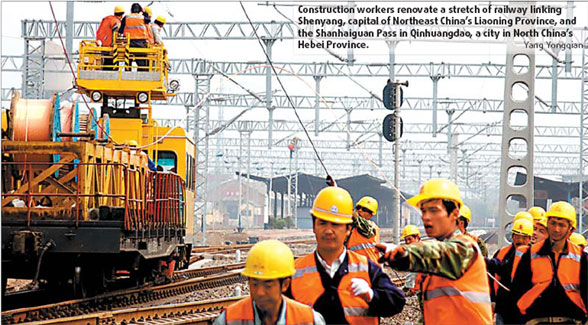Innovation for revitalization of old bases

Li Xin is a white-collar worker in an advertising firm in Shenyang, capital of Northeast China's Liaoning Province. However, he prefers to live in Fushun, a neighboring city.
He bought a 90-sq m apartment in Fushun, which would have otherwise cost him twice as much if it were located in Shenyang.
Thus he has to set off at half past six every morning for his commute to the capital city.
"I have saved a lot in home purchase but have to spend more in transportation and communication," Li said. "However, things are going to get better."
The Shenyang-Fushun expressway, which has a 14-year history of operation, has recently been made toll-free and is being expanded.
When the construction of the light rail linking the two cities is completed in two years, Li's 80-minute commute will be shortened to less than half an hour.
In addition to transportation, Shenyang and Fushun plan to pool other resources in communication, industries, technology, health care, education, and financial services.
What has prompted the sharing is a two-city integration development strategy jointly launched by the cities.
According to the strategy, Shenyang, a key hub of the northeastern region, and Fushun, a resource-based city that used to be known for rich coal reserves and is now seeking to change its economic growth mode, will forge closer ties in a bid to serve as an engine to spur regional development.
"We encourage innovation in the revitalization of traditional industrial bases in Northeast China," said Zhang Baoguo, chairman of the State Council's Office of the Leading Group for Revitalizing Northeast China and Other Old Industrial Bases and vice-director of the National Development and Reform Commission.
"And the Shenyang-Fushun integration is a good try," he pointed out.
Zhang made the speech at a forum on the Shenyang-Fushun integration strategy held in the capital on September 11 and 12.
He said his office will pay close attention to the progress of the cities' integration and extend support to the scheme.
Shenyang and Fushun, two neighboring cities connected by the Hunhe River, are less than 10 km apart.
Shenyang's edge in industries, human resources and technology complement the resources, raw materials and labor force of Fushun, which will help reduce production and circulation costs and widen the development scope of the cities.
Like Li Xin, a great number of commuters shuttle between the two cities for their jobs. During the Shenyang China International Horticultural Expo last year, flowers in pots were mostly supplied by Fushun farmers. Also, around one-fourth of the capital's annual water supply comes from the Dahuofang Reservoir in Fushun. Sales of Fushun's auto and machinery component sector, which are complementary to Shenyang's auto and machinery manufacturing industries, exceeded 160 million yuan in 2006.
The geological relation and complementary resources thus create ideal conditions for the two cities to implement the integration plan, say experts.
Behind the integration strategy are win-win goals: improving Shenyang's comprehensive competitiveness and enhancing its leading role in driving regional economic growth, and meanwhile developing new industries and creating more jobs for Fushun.
Pilot area
A 558-sq km junction area of the two cities has been designated as pilot area for the ambitious plan.
The Architectural Design and Research Institute of Tongji University has already completed the area planning project, as authorized by the two city governments.
With the Hunhe River meandering through it, the pilot area is divided into two parts - an ecological zone north of the river and an industrial zone to the south.
The ecological zone, seen as the "green lung" of the city cluster under integration, will consist of a tourism destination, an economic and technological development zone and some Fushun urban areas.
Planners said that the ecological zone will be developed as a holiday resort and business travel center.
The industrial zone in the south is another focus of the area plan.
Considering the industrial upgrading trend, the project team noted that new industries and technology-intensive sectors that feature in low or non-polluted production facilities, will be given priority acceptance in the zone.
Planners have decided to develop electronic information, eco-technology, new special equipment manufacturing, cultural creative industry, research and development, energy saving and environmental protection, and modern service industries as pillar sectors of the zone, in a bid to build a national new industrial base.
To take the integration scheme forward, the authorities have started three transportation projects - renovating overpasses in Shenyang and Fushun, building an intercity road and offering bus services between the cities.
The two cities are expected to realize full integration by 2015.
Sponsored by the provincial government, worldwide tenders have been invited for further plans under the integration scheme.
More than 20 design and planning institutes have so far submitted bids, with the final results expected to be announced at the end of this year.
(China Daily 10/12/2007 page18)














